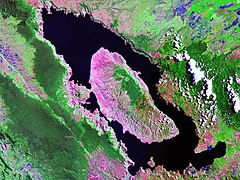
Back نظرية كارثة توبا Arabic Вядомыя вывяржэнні вулкана Тоба Byelorussian তোবা বিপর্যয় তত্ত্ব Bengali/Bangla Teoria de la catàstrofe de Toba Catalan Tobská katastrofa Czech Toba-Katastrophentheorie German Teoría de la catástrofe de Toba Spanish Tobaren katastrofearen teoria Basque نظریه فوران آتشفشان توبا Persian Théorie de la catastrophe de Toba French
| Youngest Toba eruption | |
|---|---|
 Artist's impression of early stages of eruption from about 42 km (26 mi) above northern Sumatra | |
| Volcano | Toba Caldera Complex |
| Date | c. 74,000 years BP |
| Location | Sumatra, Indonesia 2°41′04″N 98°52′32″E / 2.6845°N 98.8756°E |
| VEI | 8 |
| Impact | Covered the Indian subcontinent in 5 cm (2.0 in) of ash,[1] volcanic winter may have caused a severe human population bottleneck |
| Deaths | (Potentially) almost all of humanity, leaving around 3,000–10,000 humans left on the planet |
 Lake Toba is the resulting crater lake | |
The Toba eruption (sometimes called the Toba supereruption or the Youngest Toba eruption) was a supervolcanic eruption that occurred about 74,000 years ago during the Late Pleistocene[2] at the site of present-day Lake Toba in Sumatra, Indonesia. It was the last in a series of at least four caldera-forming eruptions at this location, with the earlier known caldera having formed around 1.2 million years ago.[3] This last eruption had an estimated VEI of 8, making it the largest-known explosive volcanic eruption in the Quaternary, and one of the largest known explosive eruptions in the Earth's history.
- ^ Petraglia, Michael D.; Ditchfield, Peter; Jones, Sacha; Korisettar, Ravi; Pal, J.N. (2012). "The Toba volcanic super-eruption, environmental change, and hominin occupation history in India over the last 140,000 years". Quaternary International. 258: 119–134. Bibcode:2012QuInt.258..119P. doi:10.1016/j.quaint.2011.07.042. ISSN 1040-6182.
- ^ "Surprisingly, Humanity Survived the Super-volcano 74,000 Years Ago". Haaretz.
- ^ Stratigraphy of the Toba Tuffs and the evolution of the Toba Caldera Complex, Sumatra, Indonesia